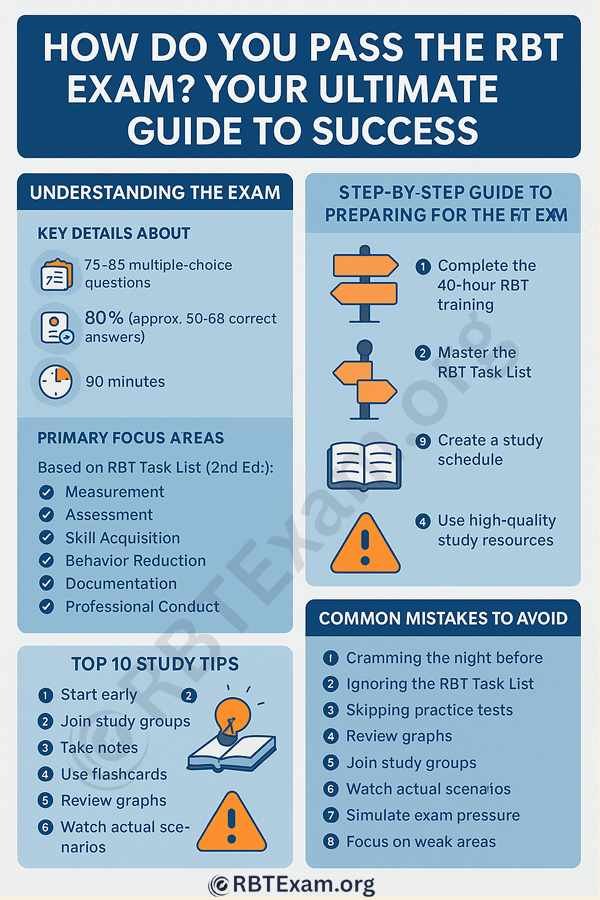How Do You Pass the RBT Exam? Your Ultimate Guide to Success
Passing the Registered Behavior Technician (RBT) test requires a comprehensive study strategy, thorough knowledge of the RBT Task List, and regular practice with simulated tests. Achieving the needed 80% passing score on this 75-question, 90-minute multiple-choice test depends critically on completing the requisite 40-hour training, comprehending fundamental ideas like behavior measurement and ethical conduct, and employing high-quality study materials.
This extensive guide ensures you will be ready to start your career in Applied Behavior Analysis (ABA) by providing concrete advice, thorough lists, and professional tactics to help you boldly prepare for and ace the RBT test.
The Behavior Analyst Certification Board (BACB) administers the RBT exam, which assesses your ability to apply AVA ideas in practical situations. Working directly with clients—often children with autism—under the direction of a Board Certified Behavior Analyst (BCBA) is a key step toward certification as RBT. With a 77% first-time pass rate in 2022, one must be well-prepared if one hopes to rank among successful applicants. With special lists and tables to enhance your preparation and keep you interested, this article breaks down everything you need to know—from test format to study strategies.

Understanding the RBT Exam: What You Need to Know
Let’s define what the RBT test consists of before delving into study plans. Computed from 85 multiple-choice questions, 75 of which are scored, the exam must be finished in 90 minutes at a Pearson VUE testing facility. Based on the RBT Task List (2nd Edition), the test covers six fundamental domains: Measurement, Assessment, Skill Acquisition, Behavior Reduction, Documentation and Reporting, and Professional Conduct. Though the BACB has a scaled scoring methodology based on subject matter experts, you must pass with at least 80%—about 60 right answers.
Key Details About the RBT Exam
| Exam Component | Details |
|---|---|
| Total Questions | 75-85 multiple-choice (scored + unscored pilot questions) |
| Passing Score | 80% (approx. 60-68 correct answers) |
| Time Limit | 90 minutes |
| Test Format | Computer-based at Pearson VUE testing centers or online via remote proctoring |
| Primary Focus Areas | Based on the RBT Task List (2nd Ed.) – Measurement, Assessment, Skill Acquisition, Behavior Reduction, Documentation, Professional Conduct |
See our guide on RBT Exam Structure to have a closer look at the test framework.
Success starts with knowing the structure and substance of the test. Usually involving real-world situations, the questions call for applying ABA ideas instead than merely memorizing data. See the RBT Task List for a comprehensive overview of the abilities and knowledge examined to get a thorough break-down.
Why Passing the RBT Exam Matters
Getting RBT certification provides doors to a fulfilling career in AVA, where you can assist people with developmental disabilities—especially autism—in environments like homes, clinics, and classrooms. Certification shows your dedication to ethical behavior, increases your credibility, and boosts employment possibilities. Passing the test marks a major turning point toward substantial effect as the demand for competent RBTs rises.
Let us now discuss the doable actions and tools to enable you to confidently pass the RBT test. Comprehensive lists and tables meant for great readability and loaded with useful suggestions are underneath.
Step-by-Step Guide to Preparing for the RBT Exam
The foundation of success on the RBT test is preparation. Use these guidelines to construct a disciplined and efficient study schedule.
1. Complete the 40-Hour RBT Training
You have to finish a 40-hour training course compliant with the RBT Task List before you can take the RBT test. Start by completing your 40-hour RBT training to be eligible. Usually offered by companies or web sites, this training teaches ABA principles, ethics, and useful applications. Verify that your training satisfies qualifying criteria via BACB-approved certification.
- Choose a Reputable Provider: Choose programs from companies such as MedCerts or Hopebridge, which provide thorough instruction along with test preparation help.
- Engage Actively: To help you remember, jot notes, ask questions, and engage in practical projects.
- Review Key Concepts: Emphasize highly tested phrases include reinforcement, motivating, and data collecting.
2. Master the RBT Task List
Your test road map is the RBT Task List. It covers the six domains’ worth of information and abilities you will be assessed upon. Every domain and its weight on the test are broken out here:
| Domain | Number of Questions | Key Topics |
|---|---|---|
| Measurement | 12 | Data collection, frequency, duration, latency, graphing |
| Assessment | 6 | Preference assessments, identifying client needs |
| Skill Acquisition | 24 | Discrete trial training, natural environment training, prompting, fading |
| Behavior Reduction | 12 | Functional behavior assessments, intervention strategies |
| Documentation and Reporting | 10 | Progress notes, communication with supervisors, compliance with regulations |
| Professional Conduct | 11 | Ethics, confidentiality, professional boundaries |
Pro Tip: From the BACB website, get the RBT Task List and carefully go over every item. To increase memorability, make flashcards using important phrases.
3. Create a Study Schedule
A disciplined study schedule guarantees you cover of the required content and helps avoid exhaustion. This is a weekly calendar specifically for RBT exam preparation:
| Day | Focus Area | Tasks |
|---|---|---|
| Monday | Measurement | Review data collection methods, practice graphing scenarios |
| Tuesday | Assessment | Study preference assessments, complete 10 practice questions |
| Wednesday | Skill Acquisition | Learn prompting techniques, watch ABA YouTube tutorials |
| Thursday | Behavior Reduction | Review intervention strategies, create flashcards for key terms |
| Friday | Documentation and Reporting | Practice writing progress notes, study BACB ethics code |
| Saturday | Professional Conduct | Review ethical scenarios, take a 20-question mock exam |
| Sunday | Full Review | Take a full-length practice test, review incorrect answers |
Tip: Study for 1-2 hours every day, breaking off quick breaks every twenty-25 minutes to keep concentration. Change the plan according to your shortcomings and strengths.
4. Use High-Quality Study Resources
To replicate test circumstances and strengthen your knowledge, invest in dependable study materials. These are the best materials for your review:
- RBT Exam Study Guide by RBTExam.com: Covers all Task List domains with practice questions and clear explanations. Knowing how many questions are on the RBT exam can help you structure your preparation.
- ABA Wizard BT Exam App: Offers mobile-friendly practice tests and flashcards for on-the-go studying.
- YouTube Channels: Channels like ABA Made Easy provide free video reviews of Task List topics.
- Free Practice Tests: Websites like rbtexam.org offer mock exams and quizzes to test your knowledge.
5. Practice with Mock Exams
One of the best approaches to get ready is to practice on tests. They help you to better manage your time, acquaint you with the exam structure, and point up areas needing work. Try to schedule at least one whole-length practice exam every week.
- Where to Find Practice Tests: Try the 75-question RBT practice test for a realistic exam simulation.
- Analyze Your Results: Review incorrect answers to understand your mistakes and focus on weak areas.
- Mimic Exam Conditions: Take practice tests in a quiet environment with a 90-minute timer to build stamina.
6. Focus on Application-Based Questions
The RBT exam stresses using AVA ideas in practical situations. You could be asked, for instance, how to respond to a client’s difficult conduct or decide which prompting tactic to use. To hone your critical thinking, work through scenario-based questions.
Example Question:
A child refuses to complete a task during a session. What should the RBT do first?
A) Ignore the behavior
B) Conduct a preference assessment
C) Provide a reinforcer
D) Consult the BCBA
Correct Answer: D) Consult the BCBA
Explanation: Always seek guidance from your supervisor before implementing new strategies.
7. Study Ethics Thoroughly
The RBT exam consists in great part on ethics. With an eye on confidentiality, professional limits, and ethical decision-making, familiarize yourself with the BACB RBT Ethics Code (2.0).
- Key Ethical Principles:
- Maintain client confidentiality at all times.
- Avoid dual relationships with clients or their families.
- Seek supervision when faced with ethical dilemmas.
Resource: The BACB website provides a free downloaded RBT Handbook including with ethical questions for samples.
8. Prepare for Test Day
Good test-day planning increases performance and helps to lower anxiety. Apply these guidelines:
- Get Enough Rest: Aim for 7-8 hours of sleep the night before.
- Arrive Early: Reach the Pearson VUE testing center 30 minutes early with a valid ID.
- Use the Flag Feature: If unsure about a question, flag it and return to it later to manage time effectively.
- Stay Calm: Take deep breaths if you feel anxious during the exam.
Top 10 Study Tips for RBT Exam Success
These professional advice gathered from seasoned RBTs and BCBAs will help you make your preparation even more successful:
- Start Early: Begin studying at least 6-8 weeks before your exam date to avoid cramming.
- Use SAFMEDS Flashcards: Create “Say All Fast Minute Everyday Shuffle” flashcards to master key terms quickly.
- Join Study Groups: Collaborate with peers to discuss concepts and share resources.
- Watch Real-World Scenarios: Observe ABA sessions (if possible) or watch videos to see concepts in action.
- Focus on Weak Areas: Use practice test results to identify and prioritize topics you struggle with.
- Take Notes Strategically: Summarize key concepts in your own words to improve retention.
- Simulate Exam Pressure: Practice under timed conditions to build confidence.
- Review Graphs: Practice interpreting behavioral data graphs, as they often appear on the exam.
- Stay Updated: Check the BACB website for any changes to the RBT Task List or exam requirements.
- Reward Yourself: Celebrate small study milestones to stay motivated.
Common Mistakes to Avoid During RBT Exam Prep
Steering clear of mistakes may save you time and tension. Here is a list of typical errors together with pointers on avoiding them:
| Mistake | How to Avoid |
|---|---|
| Cramming the night before | Spread studying over weeks with a consistent schedule. |
| Ignoring the RBT Task List | Use the Task List as your primary guide for study topics. |
| Skipping practice tests | Take at least 3-5 full-length mock exams before test day. |
| Neglecting ethics | Review the BACB Ethics Code thoroughly. |
| Poor time management during the exam | Practice pacing with timed mock tests to finish within 90 minutes. |
What to Do If You Don’t Pass the RBT Exam
Not failing the RBT test marks only one end of the path. With a 7-day waiting period between tries, you can retake it up to eight times within 12 months of your initial effort. Every retake comes with a $45 expense. Here is how one could recover:
- Review Your Performance: Identify weak areas by reflecting on your practice test results.
- Seek Feedback: Consult your BCBA supervisor for targeted advice.
- Adjust Your Study Plan: Focus on areas where you struggled and take additional practice tests.
- Stay Positive: Use the experience as a learning opportunity to strengthen your knowledge.
For more details on the exam’s passing score, visit RBT Exam Passing Score.
Additional Resources to Boost Your Preparation
Review these high-authority resources to help your study efforts be even more successful:
- BACB Official Website: Access the RBT Handbook, Task List, and ethics code directly from the source.
- Pearson VUE: Familiarize yourself with the testing center’s procedures and requirements.
- Autism Speaks: Offers insights into ABA therapy and its applications, helping you contextualize your learning.
FAQ
1. What is the passing score for the RBT exam?
You must score at least 80%, which is approximately 60 out of the 75 scored questions.
2. How many questions are on the RBT exam?
The exam consists of 85 multiple-choice questions, but only 75 are scored; the remaining 10 are pilot questions.
3. How long do I have to complete the RBT exam?
You have 90 minutes to complete the test.
4. What topics are covered on the RBT exam?
The exam is based on the RBT Task List (2nd Edition) and includes Six areas—Measurement, Assessment, Skill Acquisition, Behavior Reduction, Documentation and Reporting, and Professional Conduct. Also prepare for the hands-on RBT competency assessment, which many find challenging.
5. Where can I take the RBT exam?
Exam can be taken online via remote proctoring or at a Pearson VUE testing facility.
6. How many times can I retake the RBT exam?
With a 7-day waiting period between each test, you might retake the exam up to 8 times within 12 months following your first one.
7. What happens if I don’t pass the RBT exam?
Following the required waiting time, go over your weak points, change your study schedule, and repeat the test.
8. Do I need to complete training before taking the exam?
Yes, before applying for the test, you have to finish a 40-hour training program compliant with the RBT Task List.
9. Are there official study materials available?
Yes, the BACB offers a formal RBT Task List and Handbook. Online also are extra tools including study guides, applications, and simulated tests.
10. Why is RBT certification important?
RBT certification lets you start a career in Applied Behavior Analysis (ABA) and work directly with clients under the direction of a BCBA, therefore aiding people with developmental impairments.
Final Thoughts: Your Path to RBT Certification
With the correct resources, preparation, and attitude, passing the RBT test is a realistic objective. Mastery of the RBT Task List, practice with simulated tests, and discipline will help you to acquire your certification and begin a rewarding career in ABA. On exam day, keep cool, make sensible use of your time, and believe in your preparation. By means of commitment and these techniques, you are not only getting ready to pass the test but also setting the groundwork for a fulfilling career enabling people with developmental disabilities to flourish.
All set to go on the next phase? Create your study plan right now starting with the RBT Task List. Good luck—you’ve got this!






